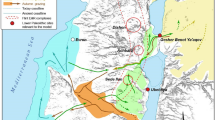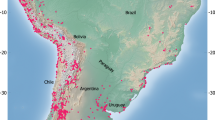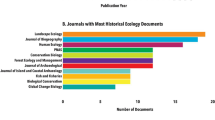Abstract
Over the past decades, the disciplinary boundaries between Roman history and archaeology have begun to fade, as archaeological proxy data started playing an important role in studying socioeconomic processes and phenomena. This is especially true for several key debates such as those on Roman economic performance, diet and nutrition, and migration and mobility. More recently, archaeological sciences, such as stable isotope studies, have increasingly started contributing to these debates too. This paper is aimed at reviewing the valuable contributions stable isotope studies can make to these debates from the economic historian’s perspective and focuses on the interpretative side of such studies: what sort of economic meaning is attributed to certain results? It will be ascertained that there sometimes seems to be a divergence between the interpretations made by isotope experts and what many economic historians would conclude. The main cause for this lies in differences in the underlying assumptions as to the working and performance of ancient economies. We will provide examples where the same isotope results can be interpreted completely differently by switching between sets of underlying assumptions. We will argue that greater interaction between economic historians and stable isotope experts is desirable so as to avoid the emergence of parallel debates and to facilitate the construction of stronger, well-integrated narratives.
Similar content being viewed by others
References
Attema PAJ, Jongman WM (2010) Archeologie en de Romeinse economie. Tijdschrift voor Mediterrane Archeologie 44:1–5
Bintliff JL, Snodgrass AM (1985) The Cambridge/Bradford Boeotian expedition: the first four years. JFA 12(2):123–161 https://www.jstor.org/stable/530288
Bintliff JL, Snodgrass AM (1988) Off-site pottery distributions: a regional and interregional perspective. Curr Anthropol 29(3):506–513 https://www.jstor.org/stable/2743472
Bintliff J (2013) The Hellenistic to Roman Mediterranean: a proto-capitalist revolution? In: Kerig T, Zimmermann A (eds) Economic archaeology: from structure to performance in European archaeology, Dr. Rudolf Habelt GmbH, Bonn, pp 285–292
Bogaard A, Heaton THE, Poulton P, Merbach I (2007) The impact of manuring on nitrogen isotope ratios in cereals: archaeological implications for reconstruction of diet and crop management practices. J Archaeol Sci 34(3):335–443. https://doi.org/10.1016/j.jas.2006.04.009
Bogaard A, Fraser R, Heaton THE, Wallace M, Vaiglova P, Charles M, Jones G, Evershed RP, Styring AK, Andersen NH, Arbogast R-M, Bartosiewicz L, Gardeisen A, Kanstrup M, Maier U, Marinova E, Ninov L, Schäfer M, Stephan E (2013) Crop manuring and intensive land management by Europe’s first farmers. PNAS 110(31):12589–12594. https://doi.org/10.1073/pnas.1305918110
Bourbou C (2019) The bioarchaeology of the Roman diet. In: Erdkamp P, Holleran C (eds) The Routledge handbook of diet and nutrition in the Roman world. Routledge, London, pp 77–90
Bourbou C, Fuller BT, Garvie-Lok SJ, Richards MP (2011) Reconstructing the diets of Greek Byzantine populations (6th-15th centuries AD) using carbon and nitrogen stable isotope ratios. Am J of Phys Anthropol 146(4):569–581. https://doi.org/10.1002/ajpa.21601
Bowes K, Mercuri AM, Rattigheri E, Rinaldi R, Arnoldus-Huyzenveld A, Ghisleni M, Grey C, Mackinnon M, Vaccaro E (2017) Peasant agricultural strategies in southern Tuscany: convertible agriculture and the importance of pasture. In: de Haas TCA, Tol GW (eds) The economic integration of Roman Italy: rural communities in a globalizing world. Brill, Leiden, pp 170–199
Bowman AK, Wilson A (2009) Quantifying the Roman economy: integration, growth, decline? In: Bowman AK, Wilson A (eds) Quantifying the Roman economy: methods and problems. Oxford University Press, Oxford, pp 3–84
Brown T, Brown, K (2011) Biomolecular archaeology: an introduction. Wiley-Blackwell, Chichester
Bruun C (2010) Water, oxygen isotopes, and immigration to Ostia-Portus. JRA 23:109–132. https://doi.org/10.1017/S1047759400002324
Cappers R, Heinrich FBJ, Kaaijk S, Fantone F, Darnell J, Manassa C (2014) Barley revisited: production of barley bread in Umm Mawagir. In: Accetta K, Fellinger R, Lourenço Gonçalves P, Musselwhite S, van Pelt WP (eds) Current research in Egyptology 2013: proceedings of the fourteenth annual symposium. Oxbow, Oxford, pp 49–63
Clapham AJ, Rowley-Conwy PA (2007) New discoveries at Qasr Ibrim, lower Nubia. In: Cappers RTJ (ed) Fields of change: progress in African archaeobotany. Barkhuis Publishing, Eelde, pp 157–164
Copley MS, Jim S, Jones V, Rose P, Clapham A, Edwards DN, Horton M, Rowley-Conwy P, Evershed RP (2004) Short- and long-term foraging and foddering strategies of domesticated animals from Qasr Ibrim, Egypt. J Archaeol Sci 31(9):1273–1286. https://doi.org/10.1016/j.jas.2004.02.006
de Haas TCA, Tol GW (eds) (2017) The economic integration of Roman Italy: rural communities in a globalizing world. Brill, Leiden/Boston
Erdkamp P (1999) Agricultural, underemployment and the cost of rural labour in the Roman world. CQ 49:556–572 https://www.jstor.org/stable/639879
Erdkamp P (2015) Agriculture, division of labour, and the paths to economic growth. In: Erdkamp P, Verboven K, Zuiderhoek A (eds) Ownership and exploitation of land and natural resources in the Roman world. Oxford University Press, Oxford, pp 18–39
Erdkamp P (2016) Economic growth in the Roman Mediterranean world: an early goodbye to Malthus? Explor Econ Hist 60(c):1–20. https://doi.org/10.1016/j.eeh.2015.11.004
Erdkamp P (2020) Population, technology, and economic growth in the Roman world. In: Erdkamp P, Verboven K, Zuiderhoek A, (eds) Capital, investment and innovation in the Roman world. Oxford University Press, Oxford, pp 39–66
Erdkamp P (forthcoming) The diet of Roman soldiers in the North-West provinces of the Roman Empire
Finley MI (1973) The ancient economy. University of California Press, Los Angeles
Fogel RW, Engerman SL (1974) Time on the cross: the economics of American slavery. W.W. Norton & Company, Inc., London
Garnsey P (1999) Food and society in classical antiquity. Cambridge University Press, Cambridge
Groenestein CM, van Faasen HG (1996) Volatilization of ammonia, nitrous oxide and nitric oxide in deep-litter systems for fattening pigs. J Agric Eng Res 65(4):269–274. https://doi.org/10.1006/jaer.1996.0100
Hanson VD (1998) Warfare and agriculture in Classical Greece. Revised edition. University of California Press, Los Angeles
Heinrich FBJ (2012) Nitrogen and carbon stable isotope analysis and manuring: agricultural practices in the Upper Thames Valley during the Iron age and Roman period: the case of Gravelly Guy. Unpublished MSc dissertation, University of Oxford
Heinrich FBJ (2017) Modelling crop-selection in Roman Italy. The economics of agricultural decision making in a globalizing economy. In: de Haas TCA, Tol GW (eds) The economic integration of Roman Italy: rural communities in a globalizing world. Brill, Leiden, pp 136–164
Heinrich FBJ (2019) Cereals and bread. In: Erdkamp P, Holleran C (eds) The Routledge handbook of diet and nutrition in the Roman world. Routledge, London, pp 101–115
Heinrich FBJ, Erdkamp P (2018) The role of modern malnutrition in modelling Roman malnutrition: aid or anachronism? J Archaeol Sci Rep 19:1016–1022. https://doi.org/10.1016/j.jasrep.2017.06.011
Heinrich FBJ, Hansen AM (2019) Pulses. In: Erdkamp P, Holleran C (eds) The Routledge handbook of diet and nutrition in the Roman world. Routledge, London, pp 116–128
Heinrich FBJ, Hansen AM (2020) Mudbricks, cereals and the agricultural economy. Archaeobotanical investigations at the New Kingdom town. In: Budka J AcrossBorders 2: Living in New Kingdom Sai. Austrian Academy of Sciences Press, Vienna, pp 275–349
Heinrich FBJ, Hansen AM (in press) A hard row to how. Ancient climate change from the crop perspective. In: Erdkamp P, Manning JG, Verboven K (eds) Climate change and ancient societies in Europe and the Near East. Diversity in Collapse and Resilience. Palgrave Studies in Ancient Economies, Palgrave Macmillan, London
Heinrich FBJ, Hansen AM, Elskens M, Motta L, Erdkamp P (forthcoming) Modelling manuring in historical societies: economic and chemical perspectives. (provisional title)
Heinrich FBJ, Wilkins DA (2013/2014) Beans, boats and archaeobotany. A new translation of phasolus, or why the Romans ate neither kidney beans nor cow peas. Palaeohistoria 55(56)149–176
Jongman WM (2007) The early Roman empire: consumption. In: Scheidel W, Morris I, Saller RP (eds) The Cambridge economic history of the Greco-Roman world. Cambridge University Press, Cambridge, pp 592–618
Jongman WM (2017) The benefits of market integration: five centuries of prosperity in Roman Italy. In: TCA de Haas, GW Tol (eds) The economic integration of Roman Italy. Rural communities in a globalizing world. Brill, Leiden, pp 15–27
Jongman WM (2019) The economic archaeology of Roman economic performance. In: Verhagen P, Joyce J, Groenhuijzen, MR (eds) Finding the limits of the limes: modelling demography, economy and transport on the edge of the Roman empire pp 95–107. https://doi.org/10.1007/978-3-030-04576-0_6
Killgrove K, Tykot RH (2013) Food for Rome: a stable isotope investigation of diet in the Imperial period (1st–3rd centuries AD). J Anthropol Archaeol 32:28–38. https://doi.org/10.1016/j.jaa.2012.08.002
Killgrove K, Tykot RH (2018) Diet and collapse: a stable isotope study of Imperial-era Gabii (1st–3rd centuries AD). J. Archaeol. Sci. Rep.: 1041–1049. https://doi.org/10.1016/j.jasrep.2017.05.054
Kron G (2000) Roman ley-farming. JRA 13:277–287. https://doi.org/10.1017/S1047759400018924
Kron G (2005) Anthropometry, physical anthropology, and the reconstruction of ancient health, nutrition, and living standards. Historia: Zeitschrift für Alte Geschichte 54:68–83
Kron G (2012) Food production. In: Scheidel W (ed) The Cambridge companion to the Roman economy. Cambridge University Press, Cambridge, pp 156–174
Lee-Thorp JA (2008) On isotopes and old bones. Archaeometry 50(6):925–950. https://doi.org/10.1111/j.1475-4754.2008.00441.x
Martyn REV, Garnsey P, Fattore L, Petrone P, Sperduti A, Bondioli L, Craig OE (2018) Capturing Roman dietary variability in the catastrophic death assemblage at Herculaneum. J Archaeol Sci Rep 19:1023–1029
Marzano A (2013) Capital investment and agriculture: multi-press facilities from Gaul, the Iberian Peninsula, and the Black Sea region. In: Bowman AK, Wilson A (eds) Oxford studies on the Roman economy. Oxford University Press, Oxford, pp 107–141
Marzano A (2015) The variety of Villa production: from agriculture to aquaculture. In: Erdkamp P, Verboven K, Zuiderhoek A (eds) Ownership and exploitation of land and natural resources in the Roman world. Oxford University Press, Oxford, pp 187–206
Marzano A (2019) Fish and seafood. In: Erdkamp P, Holleran C (eds) The Routledge handbook of diet and nutrition in the Roman world. Routledge, London, pp 163–173
McConnan Borstad C, Garvie-Lok S, Katsonopoulou D (2018) Diet at ancient Helike, Achaea, Greece based on stable isotope analysis: from the Hellenistic to the Roman and Byzantine periods. J Archaeol Sci Rep 18:1–10. https://doi.org/10.1016/j.jasrep.2017.12.007
Meijer FJ (1984) Cato’s African figs. Mnemosyne 37(1/2):117–124
Morley N (1996) Metropolis and hinterland: the City of Rome and the Italian economy. 200 BC-AD 200. Cambridge University Press, Cambridge
Müldner G (2013) Stable isotopes and diet: their contribution to Romano-British research. Antiquity 87:137–149. https://doi.org/10.1017/S0003598X00048675
Müldner G, Chenery C, Eckardt H (2011) The ‘Headless Romans’: multi-isotope investigations of an unusual burial ground from Roman Britain. J Archaeol Sci 38:280–290. https://doi.org/10.1016/j.jas.2010.09.003
Müldner G, Britton K, Ervynck A (2014) Inferring animal husbandry strategies in coastal zones through stable isotope analysis: new evidence from the Flemish coastal plain (Belgium, 1st-15th century AD). J Archaeol Sci 41:322–332. https://doi.org/10.1016/j.jas.2013.08.010
Murphy C (2016) Finding millet in the Roman world. Archaeol Anthropol Sci 8(1):65–78. https://doi.org/10.1007/s12520-015-0237-4
Mylona D (2015) Fish. In: Wilkins J, Nadeau R (eds) A companion to food in the ancient world. Wiley Blackwell, Oxford, pp 147–159
Pitts M, Versluys MJ (eds) (2015) Globalization and the Roman world. World history, connectivity and material culture. Cambridge University Press, Cambridge
Pollard AM (2011) Isotopes and impact: a cautionary tale. Antiquity 85:631–638. https://doi.org/10.1017/S0003598X00068034
Pollard AM, Ditchfield P, McCullagh JSO, Allen TG, Gibson M, Boston C, Clough S, Marquez-Grant N, Nicholson RA (2011) ‘These boots were made for walking’: the isotopic analysis of a C4 Roman inhumation from Gravesend, Kent, UK. Am J Phys Anthropol 146:446–456. https://doi.org/10.1002/ajpa.21602
Prowse TL, Schwarcz HP, Saunders S, Macchiarelli R, Bondioli L (2004) Isotopic paleodiet studies of skeletons from the Imperial Roman-age cemetery of Isola Sacra, Rome, Italy. J Archaeol Sci 31:259–272. https://doi.org/10.1016/j.jas.2003.08.008
Prowse TL, Schwarcz HP, Saunders S, Macchiarelli R, Bondioli L (2005) Isotopic evidence for age-related variation in diet from Isola Sacra, Italy. Am J Phys Anthropol 128:2–13. https://doi.org/10.1002/ajpa.20094
Prowse TL, Schwarcz HP, Garnsey P, Knyf M, Macchiarelli R, Bondioli L (2007) Isotopic evidence for age-related immigration to Imperial Rome. Am J Phys Anthropol 132:510–519. https://doi.org/10.1002/ajpa.20541
Redfern RC, Hamlin C, Beaven Athfield N (2010) Temporal changes in diet: a stable isotope analysis of late Iron Age and Roman Dorset, Britain. J Archaeol Sci 37:1149–1160. https://doi.org/10.1016/j.jas.2009.10.022
Rutgers LV, van Strydonck M, Boudin M, van der Linde C (2009) Stable isotope data from the early Christian catacombs of ancient Rome: new insights into the dietary habits of Rome’s early Christians. J Archaeol Sci 36:1127–1134. https://doi.org/10.1016/j.jas.2008.12.015
Salazar-García DC, Romero A, García-Borja P, Subirà ME, Richards MP (2016) A combined dietary approach using isotope and dental buccal-microwear analysis of human remains from the Neolithic, Roman and Medieval periods from the archaeological site of Tossal de les Basses (Alicante, Spain). J Archaeol Sci Rep 6:610–619. https://doi.org/10.1016/j.jasrep.2016.03.002
Spurr MS (1983) The cultivation of millet in Roman Italy. Papers of the British School at Rome 51:1–15
Spurr MS (1986) Arable cultivation in Roman Italy c. 200 B.C. – c. A.D. 100. Journal of Roman Studies Monographs no. 3, Society for the Promotion of Roman Studies, London
Temin P (2012) The Roman market economy. Princeton University Press, Princeton
Thanheiser U, Walter J, Hope CA (2002) Roman agriculture and gardening in Egypt as seen from Kellis. In: Hope, CA, Bowen, GE (eds) Dakhleh Oasis Project: Monograph 11. Preliminary Reports on the 1994-1995 to 1998-1999 Field seasons. Oxbow, Oxford, pp. 299–310
Twiss KC (2019) The archaeology of food: identity, politics and ideology in the prehistoric and historic past. Cambridge University Press, Cambridge
Van Dyne BL, Gilbertson CB (1978) Estimating U.S. livestock and poultry manure and nutrient production. U.S. Department of Agriculture, commodity economics division, economics statistics and cooperatives service ESCS-12
Van der Merwe NJ, Vogel JC (1978) 13C content of human collagen as a measure of prehistoric diet in woodland North America. Nature 276:815–816
Van Neer W, Ervynck A, Monsieur P (2010) Fish bones and amphorae: evidence for the production and consumption of salted fish products outside the Mediterranean region. JRA 23:161–195. https://doi.org/10.1017/S104775940000235X
Van Pelt WP, Heinrich FBJ (2019) Emmer wheat and barley prices in the late New Kingdom: a Ramessid price paradox resolved. JEA 104(1):103–107. https://doi.org/10.1177/0307513319826839
Vika E (2011) Diachronic dietary reconstructions in ancient Thebes, Greece: results from stable isotope analyses. J Archaeol Sci 38:1157–1163. https://doi.org/10.1016/j.jas.2010.12.019
Vika E, Aravantinos V, Richards MP (2009) Aristophanes and stable isotopes: a taste for freshwater fish in Classical Thebes (Greece)? Antiquity 83:1076–1083. https://doi.org/10.1017/S0003598X00099361
Vogel JC, van der Merwe NJ (1977) Isotopic evidence for early maize cultivation in New York state. Am Antiq 42(2):238–242
Weaver P (1972) Familia Caesaris. A social study of the emperor’s freedmen and slaves. Cambridge University Press, Cambridge
White CD, Schwarcz HP (1994) Temporal trends in stable isotopes for Nubian mummy tissues. Am. J Phys Anthropol 93(2):165–187. https://doi.org/10.1002/ajpa.1330930203
Wiedemann TEJ (1985) The regularity of manumission at Rome. CQ 35(1):162–175
Wilson A (2006) Fishy business: Roman exploitation of marine resources. JRA 19(2):525–537. https://doi.org/10.1017/S1047759400006760
Wilson A (2007) Quantification of fish-salting infrastructure capacity in the Roman world. OXREP working paper: 1-11. http://oxrep.classics.ox.ac.uk/working%20papers/quantification_fishsalting_infrastructure_capacity_roman_world/
Zainaldin JL (2020) Gargilius Martialis: the agricultural fragments. Cambridge classical texts and commentaries 60. Cambridge University Press, Cambridge
Author information
Authors and Affiliations
Corresponding author
Ethics declarations
Conflict of interest
The authors declare that they have no conflict of interest.
Additional information
Publisher’s note
Springer Nature remains neutral with regard to jurisdictional claims in published maps and institutional affiliations.
Rights and permissions
About this article
Cite this article
Heinrich, F., Hansen, A.M. & Erdkamp, P. Roman isotopes and economic meaning: millets, manure, mobility, marine signals, and Malthus. Archaeol Anthropol Sci 13, 44 (2021). https://doi.org/10.1007/s12520-021-01276-6
Received:
Accepted:
Published:
DOI: https://doi.org/10.1007/s12520-021-01276-6




